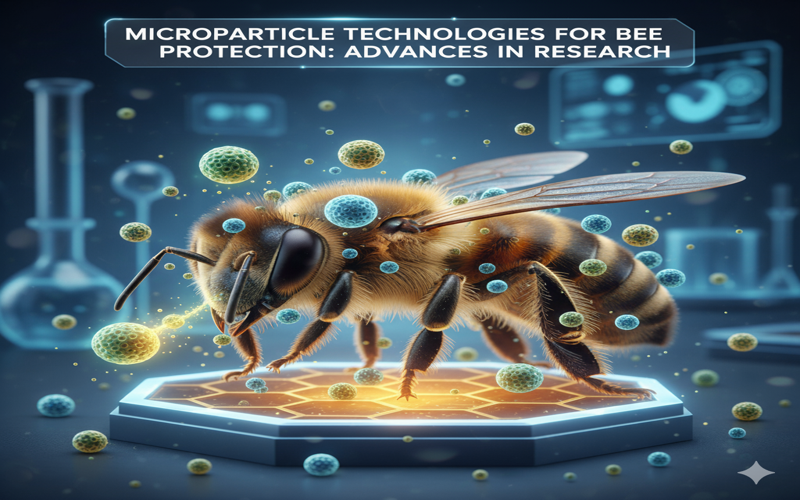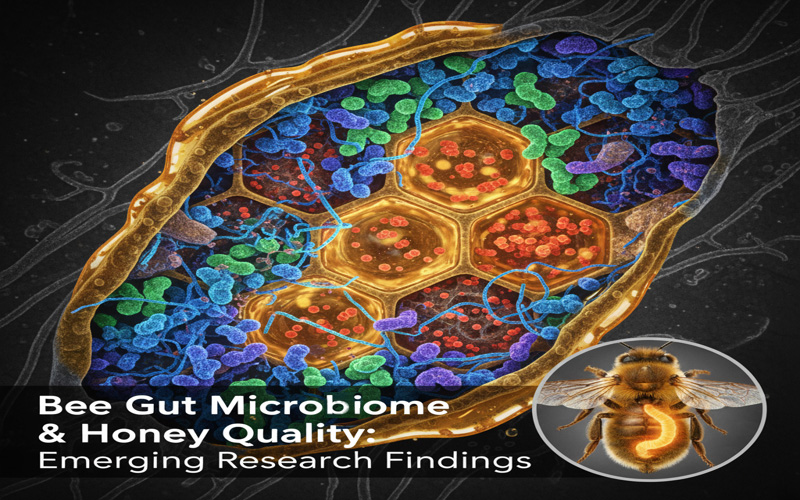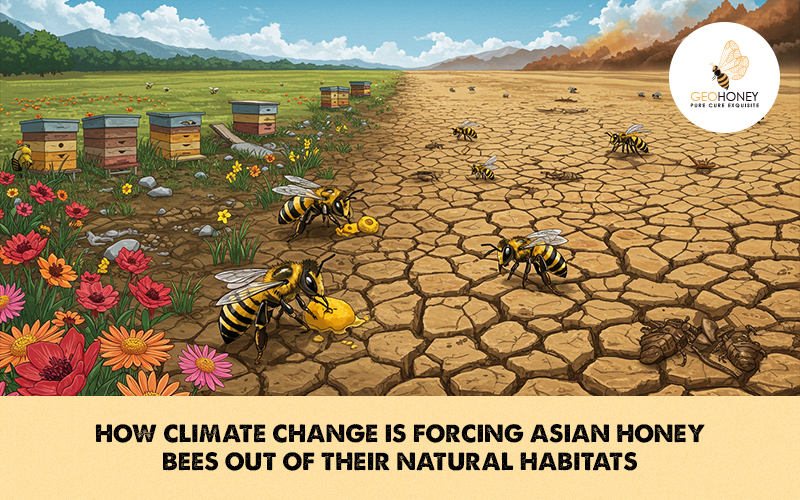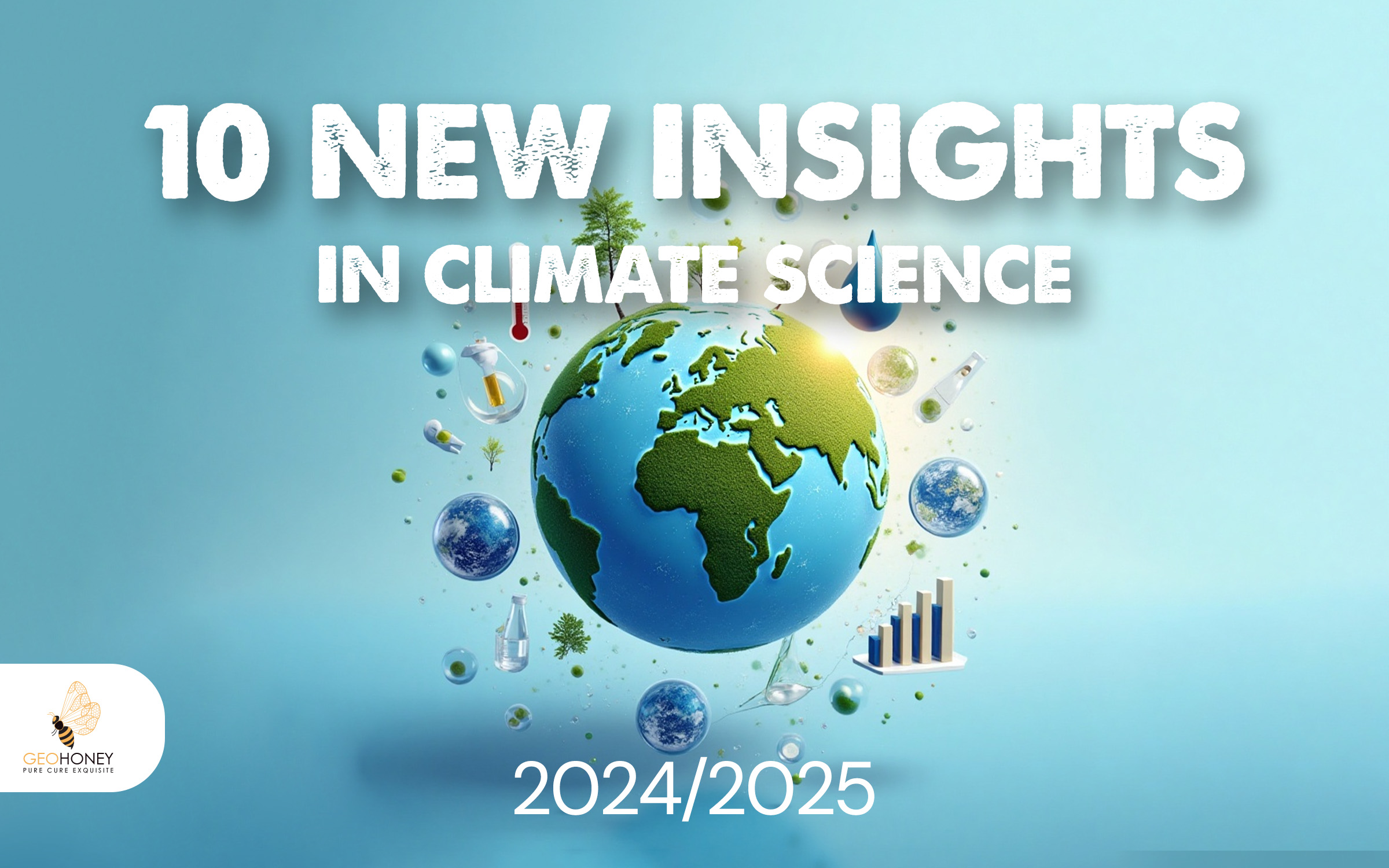- Tokyo: 12:23
- Singapore: 11:23
- Dubai: 07:23
- London: 03:23
- New York: 22:23
HONEY Researches

Microparticle Technologies for Bee Protection: Advances in Research
Bees play a central role in global food security, contributing to the pollination of nearly one-third of the world’s crops. Yet rising threats, pesticide exposure, habitat loss, pathogens, climate stress, and poor nutrition continue to shrink bee populations. In recent years, scientists have turned to microparticle technologies as a promising line of defence, offering targeted, scalable, and science-backed tools to protect bee health.This article explores the latest breakthroughs, mechanisms behind microparticle solutions, and how these innovations could reshape the future of pollinator conservation.1. Why Microparticle Technologies Matter for BeesMicroparticles, engineered particles ranging from 1 to 1000 micrometres, are ideal carriers for delivering protective compounds to bees. Their benefits include:Precision Delivery: Microparticles can carry nutrients, probiotics, antiviral agents, or detoxifying materials directly into bees’ digestive systems.Environmental Safety: Unlike chemical sprays, particles are consumed only by bees, reducing ecological risks.Controlled Release: Designed structures ensure slow, sustained delivery of active ingredients during stress periods.Compatibility with Bee Diets: Microparticles can be embedded in pollen substitutes, syrup, or sugar patties.These advantages make microparticle technology one of the most innovative approaches in apiary science.2. Current Threats Driving the Need for Microparticle Innovationa. Pesticide ToxicityNeonicotinoids and other systemic pesticides impair bees’ navigation, immunity, and memory. Microparticles are being studied as detoxification agents, binding or neutralizing toxins inside the gut.b. Viral & Bacterial PathogensVarroa mites spread viruses such as DWV (Deformed Wing Virus) at alarming rates. Microparticles can encapsulate RNA-based antiviral treatments, protecting them from degradation until they reach the bee’s circulatory system.c. Nutritional StressUrbanization and monoculture farming reduce floral diversity. Nutrient-infused microparticles can supplement amino acids, antioxidants, and essential lipids.d. Climate StressTemperature fluctuations and extreme heat weaken colonies. Some researchers are testing thermo-stable microparticles that maintain integrity under harsh seasonal conditions.3. Breakthrough Innovations in Microparticle Technologies for Bee Protectiona. Pollen-Inspired Microparticles (PIMs)Researchers have engineered microparticles that mimic the structure of real pollen.These particles:Stick efficiently to bee's body hairsAre easily ingestedDeliver active compounds safelyPIMs show strong potential for virus suppression and gut microbiome enhancement.b. Microencapsulation of Antiviral RNARNA interference (RNAi) is a promising solution against viral infections, but RNA breaks down quickly in the environment. Microencapsulation protects RNA molecules until bees ingest them, allowing:Targeted silencing of virus genesReduced colony infection ratesLow toxicity for bees and ecosystemsThis approach is currently being tested against DWV, IAPV, SBV, and other bee pathogens.c. Detoxifying Microparticles for Pesticide ProtectionScientists have developed silica-based and polymer-based microparticles that bind neonicotinoids and other pesticides inside the bee gut. Early studies show:Increased survival in bees exposed to toxinsLower oxidative stress markersImproved foraging behaviourThis technology may help offset the impact of agricultural pesticides near apiaries.d. Probiotic-Loaded MicroparticlesBee gut microbiota influences immunity, digestion, and stress resilience.Microencapsulated probiotics help:Restore healthy gut floraPrevent pathogen colonizationStrengthen immunity against mites and virusesThese microparticles remain active longer than liquid probiotic supplements.e. Microparticles for Nutrition EnhancementSpecialized particles deliver:Essential amino acidsPolyphenolsOmega-rich lipidsMicronutrientsPlant-derived antioxidantsThis technology is particularly important during seasons with limited floral resources.4. Real-World Applications and Field TrialsHive Supplements: Microparticles mixed in pollen patties have shown improvement in brood growth.Apiary-Wide Distribution: Ultra-light microparticles can be dusted at hive entrances, enabling bees to collect them naturally.Disease Management: RNAi microparticles reduce viral loads in field tests by up to 70%.Pollination Services: Healthier, protected bees provide better pollination efficiency in crops like almonds, blueberries, and canola.The field is advancing quickly, with collaborations between universities, conservation groups, and sustainable agriculture industries.5. Challenges and Future Research Directionsa. Regulatory ApprovalsRNAi-based microparticles face regulatory scrutiny, especially regarding gene-target safety.b. Large-Scale ManufacturingCreating stable, uniform microparticles in massive quantities remains expensive.c. Long-Term Ecological ImpactMore research is needed to ensure particles degrade harmlessly and do not accumulate in bee wax or honey.d. Colony-Level Behavioural ResearchStudies must evaluate how microparticles influence:Nurse bee feedingQueen healthPollen collection patternse. Integrating Microparticles With IPM (Integrated Pest Management)Future research will merge microparticles with existing tools such as thermal treatments, mechanical mite removal, and habitat restoration.ConclusionMicroparticle technologies represent one of the most promising scientific advancements for modern bee protection. By offering controlled, targeted, and environmentally safe delivery of nutrients, antivirals, detoxifying agents, and microbiome boosters, they may help mitigate multiple stressors driving global bee decline.As research progresses, these innovations could become essential tools in beekeeping, sustainable agriculture, and global food security.
Multiple | Created at: November 19, 2025 | Researched at: November 19, 2025
Read more →
Bee Gut Microbiome & Honey Quality: Emerging Research Findings
In recent years, scientists have turned their attention to a fascinating and underexplored topic: the gut microbiome of honeybees. Much like humans, bees harbor a unique community of microorganisms in their digestive system that plays a crucial role in their overall health, digestion, and immunity. Beyond maintaining colony wellbeing, emerging evidence suggests that these gut microbes may also influence the quality, composition, and medicinal properties of honey. Understanding this relationship is becoming increasingly vital for sustainable apiculture and honey production.Composition of the Bee Gut MicrobiomeThe honeybee gut hosts a relatively simple yet highly specialized microbial community dominated by just a few bacterial genera. Core members include Gilliamella apicola, Snodgrassella alvi, Lactobacillus spp., Bifidobacterium spp., and Frischella perrara. Each of these microbes occupies a specific niche within the digestive tract and serves a vital function:Gilliamella species aid in carbohydrate metabolism, breaking down complex plant polysaccharides from nectar and pollen.Snodgrassella forms a protective biofilm on the gut lining, supporting immune defense and nutrient absorption.Lactobacillus and Bifidobacterium genera contribute to fermentation processes, lactic acid production, and the inhibition of harmful bacteria.Frischella species stimulate immune responses, though excessive colonization may sometimes cause inflammation.Together, these microbes maintain digestive balance, protect bees against pathogens, and influence the processing of floral nectar into honey.Microbiome’s Impact on Honey Production & QualityHoney formation is a biologically complex process that starts with nectar collection and continues through enzymatic activity and dehydration inside the hive. Gut microbes play an active role in several of these stages.Recent studies (Kwong & Moran, 2016; Kešnerová et al., 2020) show that certain gut bacteria produce enzymes that help convert nectar sugars—mainly sucrose—into glucose and fructose, the key components of honey. They also produce antimicrobial peptides and organic acids that contribute to honey’s natural preservation and antibacterial qualities.Moreover, microbiome-driven fermentation can influence honey’s aroma, flavor, and bioactive compounds. For instance, Lactobacillus kunkeei, a species frequently found in honeybee guts and honey itself, is associated with the production of antioxidant compounds that enhance honey’s nutritional profile. These microbial contributions suggest that a healthy bee gut directly translates into higher-quality honey with richer enzymatic and medicinal properties.Environmental & Pesticide InfluenceThe bee gut microbiome is highly sensitive to external stressors. Factors such as floral diversity, pesticide exposure, and antibiotic use can significantly disrupt microbial balance (Engel et al., 2012). Bees feeding on monoculture crops or contaminated nectar often experience reduced microbial diversity, leading to weaker immunity and increased vulnerability to diseases such as Nosema and Varroa infestations.Pesticides, particularly neonicotinoids, have been shown to suppress beneficial bacteria like Snodgrassella alvi, affecting digestion and detoxification processes. This disruption not only weakens bee health but may also alter honey’s microbial and enzymatic composition, potentially affecting taste and safety. Protecting microbial diversity through natural habitats and organic farming practices is therefore essential for both bee survival and honey quality.Emerging Research & Genomic InsightsThe advent of metagenomics and next-generation sequencing has revolutionized bee microbiome research. Recent studies have decoded how microbial genes contribute to honeybee metabolism, immunity, and product quality. For example:Kešnerová et al. (2020) demonstrated that different bacterial strains specialize in breaking down pollen walls, releasing essential amino acids and fatty acids that enrich honey’s nutritional profile.Zheng et al. (2021) found that honey samples from colonies with diverse gut microbiota had higher levels of phenolic compounds and antioxidant activity.Ellegaard & Engel (2019) revealed that variations in microbiome composition across geographic regions correlate with differences in honey’s flavor, viscosity, and color.Such findings indicate that microbial diversity in bees not only supports health but also drives regional honey uniqueness, similar to terroir in winemaking.Future Directions in Bee Microbiome ResearchAs research advances, scientists are exploring microbiome manipulation as a potential tool for improving bee health and honey production. Probiotic supplementation—introducing beneficial microbes into bee diets—has shown promise in enhancing disease resistance and honey yield. Trials with Lactobacillus and Bifidobacterium strains have improved colony resilience and nectar conversion efficiency.Furthermore, microbiome engineering using synthetic microbial consortia may one day allow beekeepers to optimize honey characteristics, such as flavor and medicinal potency, through targeted microbial management. However, ethical and ecological considerations must guide such innovations to avoid disrupting natural microbial ecosystems.ConclusionThe bee gut microbiome represents a hidden but powerful force behind the quality and distinctiveness of honey. From influencing enzymatic activity and nectar processing to shaping honey’s sensory and medicinal properties, these microscopic allies are integral to the world’s favorite natural sweetener. Emerging research continues to uncover how environmental conditions, diet, and microbiome diversity interact to determine honey quality.Understanding and preserving this delicate microbial ecosystem is not only essential for sustainable beekeeping but also for ensuring the continued production of high-quality, health-promoting honey.
Multiple | Created at: October 28, 2025 | Researched at: October 29, 2025
Read more →
Detecting Honey Adulteration with Machine Learning: A New Era of Food Safety
Honey has always been celebrated as nature’s golden gift—valued for its taste, health benefits, and cultural significance. Unfortunately, its popularity also makes it one of the most frequently adulterated foods. From sugar syrups to artificial sweeteners, adulteration undermines consumer trust and threatens genuine producers. Traditional methods like pollen analysis or basic lab checks often fall short in spotting sophisticated fraud. But now, advanced technologies are changing the game.A recent study by researchers at Wollo University, Ethiopia, shows how machine learning combined with hyperspectral imaging can detect honey adulteration with accuracy above 98%. This breakthrough holds tremendous promise for protecting consumers and maintaining integrity across the honey industry.Why Honey Adulteration is a Growing ProblemCounterfeiters mix natural honey with cheaper sugars (like corn syrup or sucrose) to increase profits.Adulteration not only reduces honey’s nutritional value but can also introduce harmful substances.Rising global demand and limited authentic supply make honey an easy target for fraudulent practices.Consumers increasingly demand proof of authenticity. For brands like Geohoney, ensuring transparency and purity is a necessity.The New Approach: Machine Learning + Hyperspectral ImagingThe study introduces a cutting-edge method:Hyperspectral imaging captures both visual and spectral information from honey samples. Each wavelength acts like a fingerprint, revealing subtle differences between pure and adulterated honey.Machine learning algorithms (Artificial Neural Networks, Support Vector Machines, Random Forests, K-Nearest Neighbors, and Decision Trees) analyze these fingerprints to classify whether a sample is genuine.Through hyperparameter tuning (fine-tuning the algorithm’s internal settings), accuracy levels reached nearly 99%.Among the tested methods, Artificial Neural Networks (ANNs) performed the best, consistently identifying adulterated honey even at low levels of tampering (as little as 5–10%).Key Findings of the ResearchHigh accuracy: Over 98% classification accuracy across multiple honey types.Robust detection: Worked well across different brands and botanical origins, including premium Manuka honey.Scalability: The system can classify both “pure vs. adulterated” honey and different levels of adulteration (5%, 10%, 25%, 50%).Future-proof: As datasets expand, this technology can evolve into a universal fraud detection system for global honey markets.What This Means for the Honey IndustryTrust and Transparency: Advanced testing ensures customers receive genuine honey.Quality Control: Importers, exporters, and regulators gain a reliable, non-destructive testing tool.Brand Protection: Premium honey producers like Geohoney can safeguard their reputation and highlight authenticity as a competitive advantage.Looking AheadMachine learning is no longer just a buzzword—it’s becoming a real-world solution for food safety. For honey, this means:Better protection against counterfeit products.Faster, more accurate quality assurance.A pathway toward blockchain-backed traceability, where every jar of honey comes with scientific proof of purity.At Geohoney, we believe technology and nature can work hand in hand. By embracing innovations like hyperspectral imaging and AI, the honey industry can ensure that consumers around the world continue to enjoy honey the way nature intended—pure, authentic, and unadulterated.
| Created at: September 25, 2025 | Researched at: September 25, 2025
Read more →
Is raw honey good for weight loss in females?
Raw honey is versatile, from medicinal use to natural sweeteners and aesthetic benefits. One of the interesting benefits of raw honey is believed to be weight loss. It is said to be a natural and tasty way to support your weight loss journey, making it a staple in many diet plans. Does it help females with weight loss? Does it help lose weight in general? Let's find out. Today's blog will walk you through the nutrient profile of raw honey, help you understand its role and benefits for your body, and give you insight into its use in weight loss. So keep reading until the end. What Does 'Raw Honey' Mean?It is normal to confuse raw honey with regular honey. While some believe that raw honey is far superior to regular honey in nutritional benefits, others believe there's no difference between the two. So let's set it straight. Raw honey is best defined as honey extracted from the beehive, strained, and poured straight into the bottle for use. It skips the commercial processing methods that regular honey undergoes. Raw honey, once extracted, is poured over a mesh or a nylon cloth to remove beeswax and dead bees. That's all! It does not undergo the following two processes:Pasteurization: Process that destroys the yeast in honey by applying heat, extends its shelf life, and makes it smoother. Filtration: Process undertaken to remove debris and air bubbles. As a result, honey stays like a clear liquid. So how do the two differ? Raw honey contains higher amounts of antioxidants than its processed counterparts. It contains nearly 30 bioactive plant compounds called polyphenols, which act as antioxidants. Most processed honey does not contain any pollen, which is very nutritious. It contains over 250 substances, including vitamins, micronutrients, and antioxidants. Regular honey may have artificial sweeteners or added sugar.As a result, raw honey's health benefits may be based on its nutritional profile due to its higher antioxidant content. Why Raw Honey May Be Good for Weight Loss?Honey has been linked with weight management for quite a significant amount of time. Previous research suggests that honey has multiple physiological effects, such as:AntibacterialAnticancerAnti-inflammatoryAntioxidantImproves cardiovascular health, immune system, and gastric activity. Sugar Content in HoneyClinically, high intake of sugar has been linked with obesity and being overweight. However, it helps the body function at homeostasis when taken in appropriate amounts. Raw honey is concentrated with fructose, glucose, and small amounts of other varieties. For instance, Turanose is a type of sugar in honey that reduces fat buildup in the body. Research suggests that it lowered the activity of specific genes linked to fat production in the body. Leucrose, another sugar found in honey, helps to maintain healthy blood sugar levels. Similarly, Trehalose is believed to prevent obesity by encouraging 'browning' of white fat, which helps burn more calories. Proteins in HoneyHoney is not primarily known for its protein content because it is in very small quantities. However, the proteins and amino acids may still have a positive impact. Phenylalanine, an amino acid, helps with appetite control. Then there's Glutamine. It is the most common amino acid in blood and shows promising results for weight management. In a small study, obese women who took glutamine daily for four weeks saw a drop in both body weight and waist size. Histidine, another amino acid, has shown results for obese women. It improved insulin resistance, reduced BMI, and helped cut down fat mass. However, it is important to note that these results depend on the intake of these amino acids per kg of body weight. Even though proteins and amino acids are not present in significant amounts in honey, they may make a slight difference. Raw Honey Might Benefit Weight LossWe've covered the intricate details of the ingredients found in honey and their impact. Let's put it into perspective now. Raw honey might aid in weight loss by:Controlling Your AppetitePhenylalanine found in honey controls your appetite by suppressing it. Theoretically, this means it increases satiety and reduces small hunger pangs. As a result, it saves you from overindulging, which may contribute to weight gain. It is important to note that more research needs to be undertaken for this aspect. Protection Against Metabolic SyndromeMetabolic syndrome is a group of conditions, including high blood sugar, excess body fat around the waist, and abnormal cholesterol levels, that together increase the risk for:Cardiovascular diseaseType 2 diabetesStroke2021 research suggests that honey and its components:Balance blood sugarImprove how the body uses insulinSupport fat metabolism by lowering triglyceridesReduces bad cholesterol (LDL)Boosts good cholesterol (HDL)Together, these factors prevent weight gain, help with fat loss, and help control obesity. Proceed with CautionWhile research supports using honey for weight management and weight loss, it is essential to remember that these studies are inconclusive. Most of them were performed on rats. Since rats and humans fundamentally differ in their body process, more research needs to happen with humans. More specifically, females need to be researched upon since the biological response to raw honey may slightly differ in males and females. ConclusionRaw honey is the nutritious form of honey present today. Its unpasteurized and unfiltered form ensures that the honey retains most of its components and delivers all the benefits. However, it is essential to note that raw honey is not the same as organic honey. Remembering this point will always help you make the right choice. GeoHoney offers 100% natural, raw honey sourced from trusted beekeepers around the globe. You can use it as a natural sweetener for your beverages and desserts, as a cooking ingredient, or for its medicinal properties. Visit GeoHoney today and add the magic of raw honey to your life.
Multiple | Created at: August 21, 2025 | Researched at: August 21, 2025
Read more →
How Climate Change Is Forcing Asian Honey Bees Out of Their Natural Habitats
Asia's native honey bees—Apis cerana, A. dorsata, and A. florea—are confronting a formidable challenge: climate change is reshaping their habitats. A recent paper in the Journal of Wildlife & Biodiversity (June 2025) reveals that by 2050, average annual temperatures across their range are projected to rise by 2.3–2.5 °C, with 50–60 mm more precipitation. These changes are expected to alter foraging periods and impose intense summer heat stress (Wildlife Biodiversity,ResearchGate).Key FindingsApis florea may face an average temperature rise of +2.5 °C; A. cerana +2.4 °C; A. dorsata +2.3 °C.Increased rainfall could extend foraging in spring/winter, but hotter summers may threaten survival (Wildlife Biodiversity).Habitat suitability models (using MaxEnt and WorldClim data) show significant contraction in current ranges, especially in Pakistan. Many regions may become inhospitable during peak summer months.Broader consequencesRising temperatures may force bees upslope or poleward, disrupting existing ecosystems.Colony resilience could decline under thermal and moisture stresses.Crops and wild flora dependent on these bees may lose critical pollination services.Conservation & action stepsLandscape management: preserve corridors between cooler regions, forests, and shaded refuges.Climate-informed apiary siting: prioritize elevations and microclimates that buffer extreme temperatures.Assisted migration and breeding programs: propagate heat- and humidity-resilient subspecies.ConclusionClimate change isn't just a distant threat—it’s actively reshuffling bee habitats now. Our native Asian honey bees are at the forefront of this ecological upheaval. We cannot stand by while warming temperatures uproot pollination networks essential to agriculture and biodiversity.
Multiple | Created at: July 22, 2025 | Researched at: July 28, 2025
Read more →
Is Your Honey Safe? Shocking Levels of Pesticides Found in Bee Products
Honey is a symbol of purity, but new research tells a more troubling story. A study published in Environmental Toxicology & Pharmacology (April 2025) sampled honey, pollen, and wax foundation sheets from over 40 apiaries. The results are shocking: 96%–100% of the samples contained at least one pesticide residue—revealing chronic, widespread exposure in bee products (ResearchGate).What they foundWax foundation and pollen were nearly universally contaminated.Common agrochemicals, including neonicotinoids and fungicides, persist in hive materials.Chronic exposure—even at low levels—can subtly impair bee health by affecting development, immunity, and reproductive success (Wildlife Biodiversity,Wikipedia).Why it mattersBees ingest or contact these chemicals constantly—not just during foraging, but within the hive.Long-term exposure could accumulate, increasing risks for colony decline.Even trace levels can combine synergistically, amplifying their impact compared to single-pesticide studies .Implications for beekeepers & consumersMonitoring residue levels isn't just for regulated food safety—it's critical for hive health too.Sourcing wax foundation from pesticide-free or organic-certified suppliers can reduce contamination.Demand for raw, minimally processed honey may help reduce exposure—yet vigilance remains essential.TakeawayYour sweet spoonful of honey may be carrying unseen chemical baggage. This study urges beekeepers, consumers, and regulators to prioritize pesticide monitoring and take action to protect the intricate balance within hives.
Multiple | Created at: June 18, 2025 | Researched at: July 31, 2025
Read more →
10 New Insights in Climate Science 2024/2025
10 New Insights in Climate Science 2024/2025Source: Future Earth, The Earth League, and the World Climate Research ProgrammeEach year, the scientific community compiles the most significant recent advancements in climate science to support informed policy and societal action. The 2024/2025 edition of 10 New Insights in Climate Science—based on peer-reviewed research published between January 2023 and June 2024—synthesizes urgent findings for decision-makers, negotiators, and the broader public. Produced by Future Earth, The Earth League, and the World Climate Research Programme, this report brings together interdisciplinary knowledge to highlight both accelerating risks and emerging opportunities.The following summary presents these insights in detail, unpacking their scientific basis, implications, and recommendations for future action.Understanding the State of the ClimateThe years 2023 and 2024 have marked the hottest period ever recorded, with August 2024 registering temperatures 1.51°C above pre-industrial levels. Simultaneously, global sea surface temperatures reached historic highs, and extreme weather events—from Canada’s unprecedented wildfires to South Asia’s deadly heatwaves—have become increasingly likely and intense. These developments emphasize the need for a new level of urgency and ambition across climate mitigation, adaptation, and resilience planning.Key Scientific Insights1. Methane Levels Are Surging: A Critical Opportunity for Fast MitigationMethane, a powerful but short-lived greenhouse gas, has been rising rapidly, with emissions from fossil fuel extraction, agriculture, and waste identified as the primary drivers. Since 2006, global methane levels have accelerated sharply, surpassing historical records.Scientific Highlights:Methane is over 80 times more potent than CO₂ over a 20-year period.It has contributed ~0.5°C to global warming since the 19th century.Natural methane emissions, such as from wetlands, are also increasing due to feedback from warming.Challenges and Opportunities:Only 13% of methane emissions are currently regulated under binding policy mechanisms.Satellite monitoring now enables the identification of major methane “super-emitters.”Deep cuts in methane emissions—particularly from oil and gas operations and waste facilities—are both technically feasible and cost-effective.The agricultural sector remains harder to reform but offers mitigation potential via feed management, waste reduction, and dietary changes.Governments should incorporate explicit methane targets into their Nationally Determined Contributions (NDCs), supported by enforcement mechanisms, monitoring frameworks, and international collaboration.2. Declining Air Pollution Unmasks Underlying WarmingGlobal efforts to reduce aerosol emissions (air pollutants such as soot and sulfates) have significantly improved public health but also removed their temporary cooling effect on the atmosphere.Scientific Highlights:Aerosols reflect sunlight and cool the Earth’s surface, partially masking the warming effects of greenhouse gases.Reductions in aerosols are now exposing the full warming potential of CO₂ and methane.Regional aerosol changes are altering rainfall patterns and increasing the frequency of extreme weather events.Implications:The unintended warming effect from aerosol reduction could accelerate climate change temporarily.South and East Asia show diverging aerosol trends, influencing localized climate risks.Aerosols must be accounted for in both mitigation and adaptation plans. A global task force on aerosols—similar to methane initiatives—could help incorporate these dynamics into national strategies and inform the next IPCC guidance.3. Heat Is Rendering Regions Increasingly UninhabitableHuman health, productivity, and survival are tied to a narrow range of climatic conditions. With rising temperatures and humidity, more regions are moving outside the so-called “human climate niche.”Scientific Highlights:Over 600 million people now live in areas with conditions deemed uninhabitable for extended periods.Each degree of warming could push an additional 10% of the global population outside habitable ranges.Heat stress is especially deadly when combined with high humidity and poor infrastructure.Societal Impact:Populations in the Global South are disproportionately affected due to limited access to cooling infrastructure, healthcare, and water resources.Vulnerable groups—such as outdoor laborers, pregnant women, children, and the elderly—face the highest risks.Heat Action Plans and Early Warning Systems must be scaled urgently. Adaptation planning should prioritize urban design, labor protections, and infrastructure improvements that can mitigate the worst impacts of heat.4. Climate Change Threatens Maternal and Reproductive HealthClimate-related stressors are exacerbating health risks for women and children, particularly in low-income and climate-vulnerable regions.Scientific Highlights:Heat exposure is linked to higher rates of miscarriage, preterm birth, and maternal mortality.Floods and displacement can disrupt healthcare access and increase exposure to disease and violence.Climate-related food and water insecurity further compounds reproductive health challenges.Structural Gaps:Fewer than 25% of NDCs reference maternal or newborn health.Gendered dimensions of climate risk remain underrepresented in adaptation frameworks.Maternal and reproductive health must be integrated into climate adaptation and healthcare systems. Gender-equitable planning and investment in climate-resilient health infrastructure are essential.5. Ocean Warming Raises Alarms Over El Niño and AMOC InstabilityOceans are warming at record-breaking levels, affecting global circulation systems and atmospheric dynamics. Two key concerns are emerging:A. El Niño IntensificationEconomic losses from El Niño are now estimated in the trillions.Frequency and severity are expected to increase with warming.B. AMOC Collapse RiskThe Atlantic Meridional Overturning Circulation (AMOC) is weakening, with potential for abrupt collapse in the coming decades.This could disrupt weather patterns, sea levels, and ecosystems across the globe.Robust ocean monitoring systems and risk assessments are urgently needed. Climate models must be refined to incorporate feedback and thresholds, with increased investment in ocean–atmosphere observation networks.6. Biocultural Diversity is Key to Amazon Forest ResilienceThe Amazon is facing dual threats from climate change and human activities like deforestation and illegal mining.Scientific Highlights:Parts of the forest have shifted from carbon sinks to carbon sources.The forest is approaching ecological tipping points linked to rainfall and temperature thresholds.Solutions:Indigenous and local stewardship enhances resilience through traditional knowledge.Preserving biodiversity—both ecological and cultural—is critical to maintaining ecosystem stability.Support regional cooperation, law enforcement, and the development of sustainable economic models that prioritize conservation. Brazil’s proposed Tropical Forest Forever Fund should be operationalized by COP30.7. Infrastructure Systems Are Vulnerable to Cascading Climate RisksCritical infrastructure—such as energy grids, water systems, healthcare, and transportation—faces growing risks from extreme climate events.Scientific Highlights:Interconnected infrastructure increases the risk of cascading failures.Informal settlements, where infrastructure is weakest, are home to over 1 billion people.Emerging Tools:AI and machine learning can enhance resilience through predictive analytics, smart grids, and real-time risk monitoring.Resilience reviews must become standard practice, particularly in urbanizing regions. Investments should prioritize decentralized systems, nature-based solutions, and integration with climate adaptation strategies.8. New Frameworks Can Drive Climate-Resilient Urban DevelopmentCities are central to climate solutions but often fail to integrate mitigation and adaptation holistically.Scientific Highlights:The SETS (Social-Ecological-Technological Systems) framework offers a blueprint for aligning environmental, social, and technological priorities.Integrated urban planning can unlock co-benefits such as reduce
Multiple | Created at: May 01, 2025 | Researched at: May 02, 2025
Read more →
How Honey Bees are Changing Tibetan Grasslands: A Tale of Spillover
Multiple | Created at: April 29, 2025 | Researched at: May 01, 2025
Read more →
How the World Around Us Affects Honey Bees: A Look at Pesticides and Landscapes
Multiple | Created at: January 02, 2025 | Researched at: December 20, 2024
Read more →
The Unsung Heroes of Urban Beekeeping: How City Trees Support Honeybee Health
Multiple | Created at: November 08, 2024 | Researched at: November 08, 2024
Read more →
Honey as a Powerful Natural Ally in Cancer Treatment: What Science Says
Multiple | Created at: November 08, 2024 | Researched at: October 08, 2024
Read more →
Innovative Microparticles To Protect Bees From Pesticides
Multiple | Created at: September 13, 2024 | Researched at: September 05, 2024
Read more →We rely only on exclusive and trustworthy resources.


